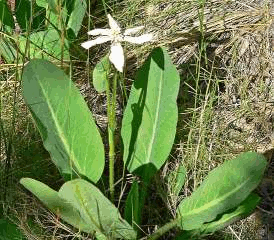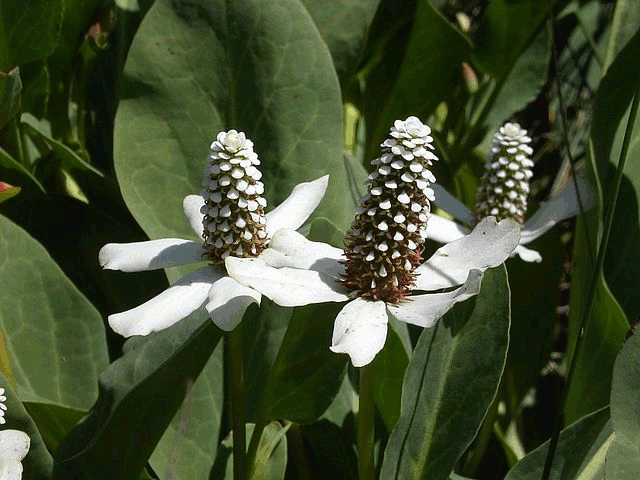Yerba Mansa
Common Names: Yerba mansa, lizard tail
Scientific Name: Anemopsis californica
Climate: Hot, temperate
Plant Description: Yerba mansa is a perennial herbaceous plant. The leaves are large and elliptical in shape and grow off the base. It has small white flowers that grow on a stem that highlights the leaves at the base. The flowers do not have true petals, but each flower is supported by a 1-3 cm long bract that is white, often tinged reddish. There are around a hundred flowers for each conical shape of the flower head. The conical structure turns into a unique and resistant fruit that can transport the water downstream to spread the small pepper-like seeds. In its natural environment it is found in humid places in varieties of environments such as valley grasslands, salt flats or in oases desert palm.
It is native to southwestern North America in northwestern Mexico and the southwestern United States..
Cultivation: Full sun or partial shade. Tolerant to any soil, but prefers saline or alkaline soil. You need slow draining soil that retains moisture.
Yerba mansa spreads easily and quickly through its roots, so it is very easy to grow it by root transplant. Best season to transplant the root is autumn or winter. To do it, start by digging up an established fleshy root. Re-plant the root in full sun and give it enough space to spread: 30 cm or more between the plants. Water transplants and keep them moist throughout the year. If it is cultivated for its roots for medicinal purposes it is necessary to sow them in a loose soil.
It can also be planted in a bucket or to build barriers on the ground when it needs to be kept from over-spreading. Keep it moist. It will appear dead after the summer but since it is perennial it will return in the spring and summer. For general maintenance dead material should be reduced at least every few years, but you can also leave dead leaves as mulch.
It usually blooms in early spring. As the plant matures during the summer, it will develop red to purple spots throughout, and the entire plant will turn dark red in the fall. The plant smells very strong, including the roots. It goes to dormancy and basically disappears from late summer to early winter, and sprouts again from the roots in late winter. The plant will grow to a maximum of 0.5 meters high and about 0.6 meters wide and is excellent for ground cover.
Yerba mansa can be difficult to harvest because it has strong roots and rhizomes that grow from those nodules. You can harvest the roots at any time, but it's best to let the plant settle and spread out a bit before doing so. Do not plant and harvest this plant in areas that have been contaminated with arsenic or heavy metals.
Because it is a ground cover plant that spreads over the ground, it can drown other plants. Cut runners at any time to control their growth.
Uses: The root of the plant was used as a medicine by many tribes in California, Great Basin, and the Southwest including the  Wukchumni Yokuts, Kawaiisu, Paiute, Shoshone, and Pima. Some Native Americans still gather the plant today. The plant has antimicrobial, antibacterial, anti-inflammatory, and anti-fungal properties. The roots have the strongest medicinal properties. The leaves have mild medicinal properties. Tea made from boiled roots can be drunk to help with colds, sore throats, coughs, and lung inflammation. For these: drink 2 cups of leaf tea a day, use 4 leaves for ½ liter of water.
Wukchumni Yokuts, Kawaiisu, Paiute, Shoshone, and Pima. Some Native Americans still gather the plant today. The plant has antimicrobial, antibacterial, anti-inflammatory, and anti-fungal properties. The roots have the strongest medicinal properties. The leaves have mild medicinal properties. Tea made from boiled roots can be drunk to help with colds, sore throats, coughs, and lung inflammation. For these: drink 2 cups of leaf tea a day, use 4 leaves for ½ liter of water.
You can also use vaporization boiling together plant’s l leaves, eucalyptus and sage. Leaf tea can be a soothing treatment for blisters, bug bites, poison ivy, sunburn, and ringworm. You can prepare a smooth and moist mash with the leaves and /or the roots. Made from the roots, it is effective to apply to swollen areas, both for inflammation of the skin and muscles. It can also be used to wash open sores and wounds with a moist mash of the root, as a disinfectant and for inflammation and pain. The root is an anti-fungal: the application of dry and powdered root can be effective against dermatitis and foot fungus. Dried and powdered root is sprayed on the wounds as a disinfectant. To relieve an upset stomach, crush the root, soak it in water and drink that water. For sore muscles, including menstrual cramps, simmer the whole leaves and/or roots in water for about 15 minutes, then make a smooth, moist puree, submerge a small rug in the liquid and apply it to the area. After delivery, taking baths with a few drops of yerba mansa tincture will help with healing. A warm tea from the roots is used to clean genital areas, as it can help with genital sores. A mild tea made from the leaves can help colicky babies and also help reduce fever.
Like many herbal teas, it works best when used a few times a day for a few days. Wash and chop 2-4 leaves per cup. The washed roots can dry out, let them wilt for a few weeks, cut them off, and allow them to dry completely.
The plant works very well as a ground cover, it will acidify and aerate the soil.
Pests and Diseases: It is resistant to pests and diseases
It can attract caterpillars.
References:
Kaul, R.B. 1986. Saururaceae. p. 79 IN: Flora of the Great Plains. R.L. McGregor, T.M. Barkley, R.E. Brooks, E.K. Schofield (eds). University Press of Kansas, Lawrence, Kansas.
Sencoval, Annette. Home Grown Healing Traditional Home Remedies from Mexico. Berkeley Books, New York, NY, 1998.
En Espanol: Yerba Mansa
